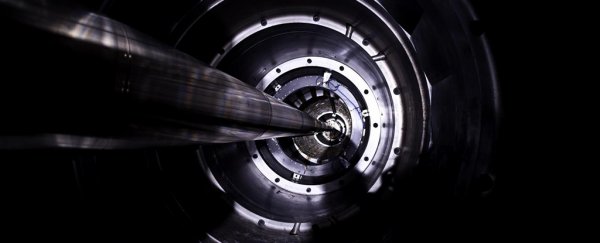The Large Hadron Collider (LHC) is the particle accelerator that just keeps on giving, and recent experiments at the site suggest we've got the first evidence for a mysterious subatomic quasiparticle that, until now, was only a hypothesis.
Quasiparticles aren't technically particles, but they act like them in some respects, and the newly recorded reactions point to a particular quasiparticle called the odderon.
It already has a name because physicists have been on its theoretical trail for the past 40 years.
Now, they still haven't seen the elusive odderon itself, but researchers have now observed certain effects that hint the quasiparticle really is there.
That would in turn give us new information to feed into the Standard Model of particle physics, the guidebook that all the building blocks of physical matter are thought to follow.
"This doesn't break the Standard Model, but there are very opaque regions of the Standard Model, and this work shines a light on one of those opaque regions," says one of the team, particle physicist Timothy Raben from the University of Kansas.
"These ideas date back to the 70s, but even at that time it quickly became evident we weren't close technologically to being able to see the odderon, so while there are several decades of predictions, the odderon has not been seen."
The reactions studied in this case involve quarks, or electrically charged subatomic particles, and gluons, which act as exchange particles between quarks and enable them to stick together to form protons and neutrons.
In proton collisions where the protons remain intact, up until now scientists have only seen this happen when an even number of gluons are exchanged between different protons. The new research notes, for the first time, these reactions happening with an odd number of gluons.
And it's the way the protons deviate rather than break that's important for this particular area of investigation. It was this phenomena that first led to the idea of a quasiparticle called an odderon, to explain away collisions where protons survived.
"The odderon is one of the possible ways by which protons can interact without breaking, whose manifestations have never been observed .. this could be the first evidence of that," Simone Giani, spokesperson at the TOTEM experiment of which this is a part, told Ryan F. Mandelbaum at Gizmodo.
It's a pretty complex idea to wrap your head around, so the researchers have used a vehicle metaphor to explain what's going on.
"The protons interact like two big semi-trucks that are transporting cars, the kind you see on the highway," explains Raben.
"If those trucks crashed together, after the crash you'd still have the trucks, but the cars would now be outside, no longer aboard the trucks – and also new cars are produced. Energy is transformed into matter."
"Until now, most models were thinking there was a pair of gluons – always an even number… We found measurements that are incompatible with this traditional model of assuming an even number of gluons."
What all of that theoretical physics and subatomic analysis means is that we may have seen evidence of the odderon at work – with the odderon being the total contribution produced from the exchange of an odd number of gluons.
The experiments involved a team of over 100 physicists, colliding billions of proton pairs together every second in the LHC. At its peak, data was being collected at 13 teraelectronvolts (TeV), a new record.
By comparing these high energy tests with results gleaned from other tests run on less powerful hardware, the researchers could reach a new level of accuracy in their proton collision measurements, and that may have revealed the odderon.
Ultimately this kind of super-high energy experiment can feed into all kinds of areas of research, including medicine, water purification, and cosmic ray measuring.
We're still waiting for confirmation that this legendary quasiparticle has in fact been found – or at least that its effects have – and the papers are currently submitted to be published in peer reviewed journals.
But it's definitely a super-exciting time for physicists.
"We expect big results in the coming months or years," says one of the researchers, Christophe Royon from the University of Kansas.
The research is currently undergoing peer review, but you can read the studies on the ArXiv.org and CERN pre-print servers.
